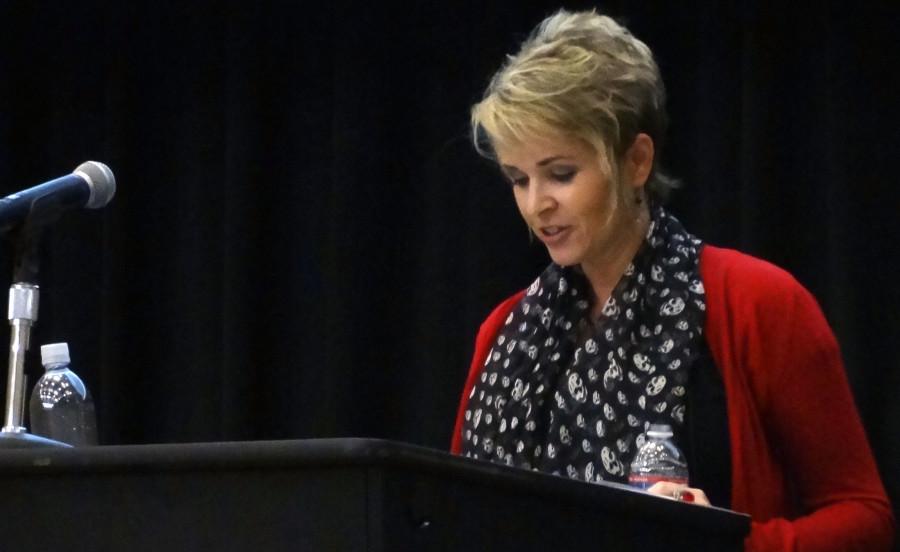Lecture presents social justice perspective on scary stories
Dr. Natalie Wilson discusses the history of our social fears
November 16, 2015
Horror themes in film, television and literature involve vampires, chainsaw-wielding men and evil witches, but socio-historical structures hide behind these fears according to Dr. Natalie Wilson.
Wilson, a professor of Literature and Women’s Studies at CSUSM, delivered a lecture entitled, “Scary Stories: What do horror stories tell us about ourselves, our society and social injustice?”
Nearly 300 people attended the Oct. 29 lecture at the USU Ballroom.
Wilson’s analysis focused on the content structure of the horror genre, which she said relies heavily on historical social constructs.
“Horror stories serve as a great social barometer, interrogating national traumas and speaking to our cultural anxieties,” said Wilson.
Wilson said her analysis reveals that social anxieties depicted in the genre mirror fears based on race, class, gender and sexuality. Wilson explained that producers of horror-based media draw from these fears to create their stories with figures that have become a part of popular culture.
“Scary stories and images thus function as an instructional medium, teaching us who not to trust, who deserves extermination and who should be kept in their place,” said Wilson.
Many of the works Wilson cited to support her research were influenced by racial groups with histories of facing discrimination and intolerance. Fictionalizing the historical suffering of groups is problematic because it diminishes the severity of the realities they faced, she said.
She referred to several instances of dehumanization of racial groups: immigrants as alien invaders, the African figures such as “Tituba” being associated with necromancy, Native people and Africans as animalistic in stories like “Little Black Sambo” and black male slaves as sex craving savages.
These illustrations become figures of aliens, witches and monstrous animals in horror stories.
“By dehumanizing certain groups and rendering them monstrous, their mistreatment can be explained,” said Wilson.
Focusing on class, Wilson said both poor and rich are demonized in horror. The poor are vilified in a way that teaches audiences to fear them, as they are associated with bad behavior and extreme violence.
The rich are also demonized for representing the unattainable American Dream—even riches can’t protect characters in films like the 2013 movie “The Purge,” as referenced by Wilson.
She also referred to the misogyny that is ingrained in horror films like “The Exorcist,” which she said communicates a message of “women should stay at home where they belong.”
The movie’s gender bending character of working, divorced mother Chris leads to the demonic possesion of her daughter, Regan, argued Wilson. She supported this understanding with a PowerPoint slide that read: “Maybe Reagan wouldn’t have turned demon if her mom had stayed married.”
Wilson further explained the demonized and evil depictions of mothers in horror films such as Jason’s mother in “Friday the 13th.”
“An overarching theme in many scary stories is that women are monsters, who can only be tamed by the presence of good men, something Dracula certainly furthers with Van Helsing and the Crew of Light,” said Wilson.
Wilson’s lecture focused on many groups that face dehumanization, as represented by a homosexual character in “Otto,” a German film, which deals with “hate crime as readily as it does American capitalism,” according to Wilson.
Dehumanization is also present in “Silence of the Lambs,” which demonizes transgender people with the representation of the main character as a serial killer who creates “a female skin suit out of their victims,” said Wilson.
But things aren’t all bad in the genre, according to Wilson.
“Indeed, there is much to like in recent horror films and television shows,” said Wilson. “The casts of zombie, vampire and witch… TV, texts as well as films, which not only features casts diverse in age, race, class, gender, bodily appearance and mental health… contain messages of tolerance and justice.”
Wilson ended her lecture on a hopeful note for the future of socio-historical depictions in horror films.
“I hope that I have managed to convince you that horror and fearlessness is powerful,” said Wilson. “…That like the feminists dressed as witches for International Women’s Day in Turkey, we can celebrate our achievements as well as remember the more horrific realities of our world.”


